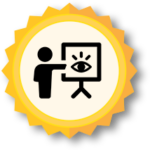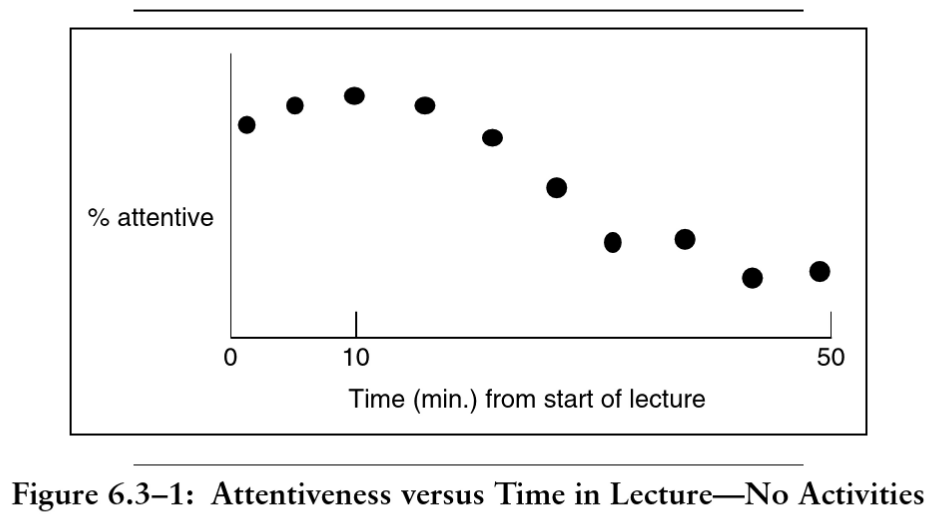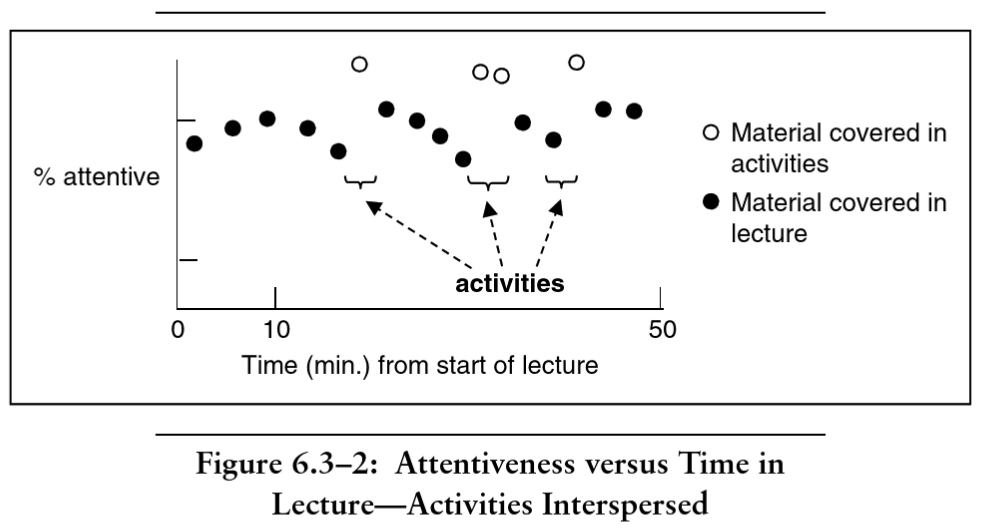Active Learning Instructional Strategy: Pose A Question
 Overview and Introduction: The WHAT and WHO
Overview and Introduction: The WHAT and WHO
As detailed in the Active Learning: Overview and Introduction Quick Reference Guide, active learning is a term used to describe instructional methods that increase student involvement and engagement in the learning process. In contrast to traditional instructor-centered delivery, where there is a passive transmission of facts and ideas through lecture, active learning incorporates a variety of instructional strategies that purposefully shift the learning environment to be more student-centered, focused on what the student will be ‘doing’ during the learning process.
When students are presented with long, uninterrupted lectures, it is easy for their attention span to waiver. One way to re-engage students is to simply pause the lecture and pose a meaningful question. Posing questions is a simple active learning strategy that requires only a few minutes of planning and class time and provides opportunities for students to reflect and apply recently-learned concepts. Questions can be socrative or reflective in nature, or they can ask students to connect the recently learned concept to topics from other courses, or to real-world situations (examples below).
*Please note that the Quick-Reference Guide you are reading explains one Active Learning Classroom idea.

 Implementation and Timing: The WHEN, WHERE, and HOW
Implementation and Timing: The WHEN, WHERE, and HOW
There is no ‘right time’ to use questioning strategies. They can be implemented at the beginning of a course as a way to reflect on content from the previous class session, during lecture-style classes as a way to improve student reflection, engagement, and attentiveness, or at the end of the class session to encourage reflection on content mastery. While there is no right answer to when questions should be included, consider research on human attention span and try to include questions at minimum every 15 minutes to encourage engagement and participation from students.
Questioning strategies are a good fit for a variety of courses and settings and can be used both in and ‘out’ of the classroom. When designing a course, consider the best use of face-to-face or synchronous time. If you’re struggling with where in your class sessions to embed questions, start by identifying a class session that includes a lot of lecture time, or one that has concepts that students find particularly challenging. Questioning strategies can improve these sessions by breaking up long lectures to re-engage students as well as providing them with time to process and reflect on the new information being shared.
*While this guide focuses primarily on in-class strategies, activities like Canvas discussion posts and after-class reflective questions are examples of out-of-class activities that leverage the value of questioning strategies for student engagement. For additional ideas on online active learning, check out the ASU Teach Online website.
Plan for Implementation: Start small and begin early
- Look over your plans for an upcoming class session and make sure they include a few good questions to ask during class.
- Explain to students why you are incorporating these activities. You may wish to share with students that these strategies have been shown to improve content comprehension, retention, and metacognitive skills.
Questions to Pose
- Ask students to define a term or concept in their own words. Felder and Brent (2016) provide this example: ‘Using terms a bright high school senior [your non-scientist friends, your grandparents] could understand, briefly define covalent bonds [viscosity, derivative, plate tectonics, Young’s modulus, leukocyte].
- Ask Socrative questions. Here are Six types of Socratic questions you can use.
- Ask probing questions. Help students reflect and clarify their understanding and reach higher levels of understanding by posing probing questions.
- Ask real-world world questions. After finishing a segment of lecture, show an image or real-world question related to the topic you have been covering. Felder and Brent (2016) provide these examples:
-
- Why is there a stable foam on top of espresso but not drip coffee?
- Why do you feel comfortable in 65°F still air, cool when a 65°F wind is blowing, and freezing in 65°F water, and even colder when you step out of the water?
- How would you expect crop yield to change if you increase the ratio of phosphorus to potassium in the soil?
- Estimate the time it will take for all of the water in a tea kettle to boil off [for the capacitor to reach 99% of its full charge, for the I-beam to collapse under the applied central load]
- Ask questions from a Concept Inventory. Concept Inventories are criterion-referenced tests designed to measure student learning on specific concepts. You can find a list of established concept inventories here and here, and can also locate questions by simply googling ‘concept inventory name and the name of your discipline or course’. Once you have identified a question that fits with your content, simply show the question as part of your presentation. Next, you can choose to: 1) ask students to think for a minute by themselves, 2) have students respond individually by voting or writing a short summary explaining their answers, or 3) ask students to discuss their answer with someone seated close to them (or in a breakout room if online).
 Sample: A bowling ball accidentally falls out of the cargo bay of an airliner as it flies along in a horizontal direction. As seen from the ground, which path (1, 2, 3, 4, or 5) would the bowling ball most closely follow after leaving the airplane.
Sample: A bowling ball accidentally falls out of the cargo bay of an airliner as it flies along in a horizontal direction. As seen from the ground, which path (1, 2, 3, 4, or 5) would the bowling ball most closely follow after leaving the airplane.
Question #23 from the Force Concept Inventory, D. Hestenes
After Class: Reflect
While the class session is still fresh in your mind, reflect on the class session and student responses to questions. Did the activity improve student comprehension of the topic? What updates or changes can you make to the questions for future classes based on this round of implementation?

 Rationale and Research: The WHY
Rationale and Research: The WHY
Felder and Brent (2016) remind us that learning requires attentiveness. Human attention spans are short and it is challenging for students to remain engaged while they are passive. Consider the typical student attention span during a standard lecture class. Attention begins to wane around the ten-minute mark in lecture. Simple activities such as reflective questions re-engage students and improve their attention span (and subsequent comprehension) throughout the class session.
“When you periodically give your student something to do that requires using recently presented information, their working memories have a chance to rehearse the information, increasing its chances of being stored in long-term memory” (p. 117, Teaching and Learning STEM).


Note: Adapted from Teaching and Learning STEM, by Felder & Brent, 2016, p 118.

 Additional Resources and References
Additional Resources and References
Felder, R. M., & Brent, R. (2016). Teaching and learning Stem: a practical guide. Jossey-BassTM, a Wiley brand.